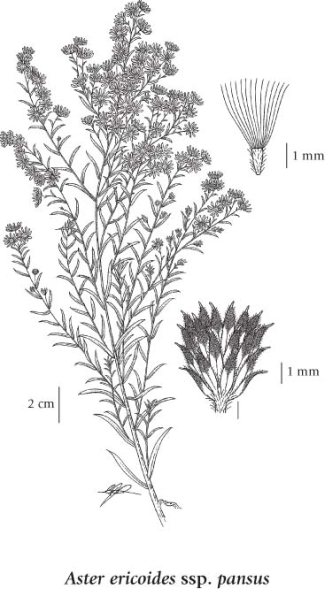Symphyotrichum ericoides var. pansum (L.) G.L. Nesom (S.F. Blake) G.L. Nesom
tufted white prairie aster
Asteraceae (Aster family)
Introduction to Vascular Plants
tufted white prairie aster
Asteraceae (Aster family)
Introduction to Vascular Plants
Map
Distribution of Symphyotrichum ericoides var. pansum
Click here to view the full interactive map and legend
Species Information
General:
Perennial herb from a fibrous-rooted short rhizome or branched, woody stem-base; stems ascending, much branched and hairy above, 30-200 cm tall.
Leaves:
Basal leaves soon deciduous; stem leaves numerous, linear, short-haired to glabrate, rough-margined, often spine-tipped, 2-7 cm long, 1-6 mm wide.
Flowers:
Heads with ray and disk flowers, usually numerous in a branched open inflorescence, tending to become one-sided on the recurving branches; involucres 4-7 mm tall; involucral bracts graduated, outermost spreading and spoon-shaped, the others mostly linear, spine-tipped, with a whitish base and firm green tips, often hairy on the margins and back; ray flowers 12-30, white, 3-8 mm long; disk flowers yellow.
Fruits:
Achenes appressed-hairy; pappus white to straw-colored.
Notes:
Aster ericoides ssp. pansus is easily confused with A. falcatus which has a similar ecology and distribution. The former, however, has numerous flowers borne on the recurved-ascending branches while the latter has flowers usually borne singly on the ends of the branches.
Illustration

If more than one illustration is available for a species (e.g., separate illustrations were provided for two subspecies) then links to the separate images will be provided below. Note that individual subspecies or varietal illustrations are not always available.
Illustration Source: The Illustrated Flora of British Columbia
Ecology
Ecological Framework for Symphyotrichum ericoides var. pansum
The table below shows the species-specific information calculated from
original data (BEC database) provided by the BC Ministry of Forests and Range.
(Updated August, 2013)
The table below shows the species-specific information calculated from
original data (BEC database) provided by the BC Ministry of Forests and Range.
(Updated August, 2013)
| Site Information |
Value / Class |
||
|
Avg |
Min |
Max |
|
| Elevation
(metres) |
905 | 525 | 1100 |
| Slope
Gradient (%) |
4 | 0 | 60 |
|
Aspect (degrees) |
221 | 135 | 315 |
| Soil
Moisture Regime (SMR) [0 - very xeric; 4 - mesic; 8 - hydric] |
5 | 2 | 7 |
| Modal
Nutrient Regime
Class |
E | ||
| #
of field plots species was recorded in: |
25 | ||
| Modal
BEC Zone Class |
IDF | ||
|
All BEC Zones (# of stations/zone) species was recorded in |
BG(1), IDF(22), PP(1), SBPS(1) | ||
|
Source:
Klinkenberg 2013
|
|||
Habitat and Range
Mesic to dry grasslands, shrublands, alkaline flats, rocky slopes, disturbed areas and open forests in the lowland, steppe and montane zones; common in SC and SE BC, less frequent in NE BC, rare on S Vancouver Island; N to YT and NT, E to MB and S to UT, AZ and OR.Status Information
Synonyms
Synonyms and Alternate Names:
Aster ericoides subsp. pansus (S.F. Blake) A.G. Jones
Aster ericoides var. pansus (S.F. Blake) B. Boivin
Aster multiflorus var. pansus S.F. Blake
Aster pansus (S.F. Blake) Cronquist
